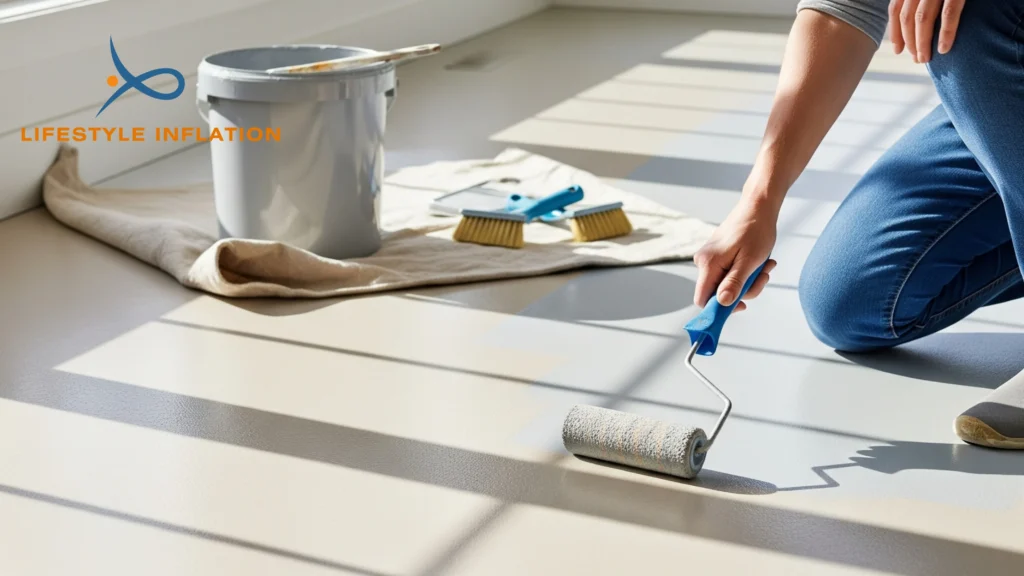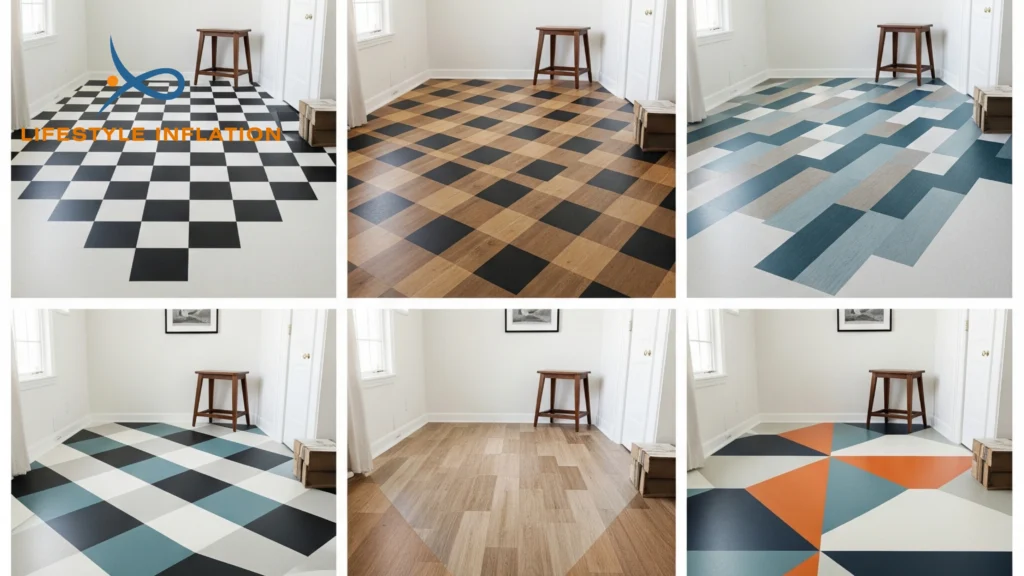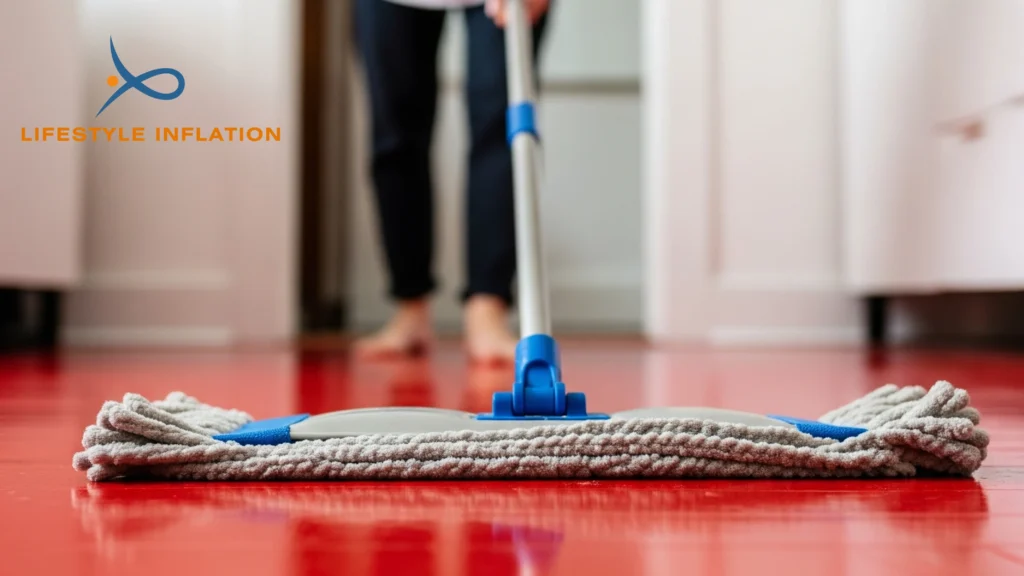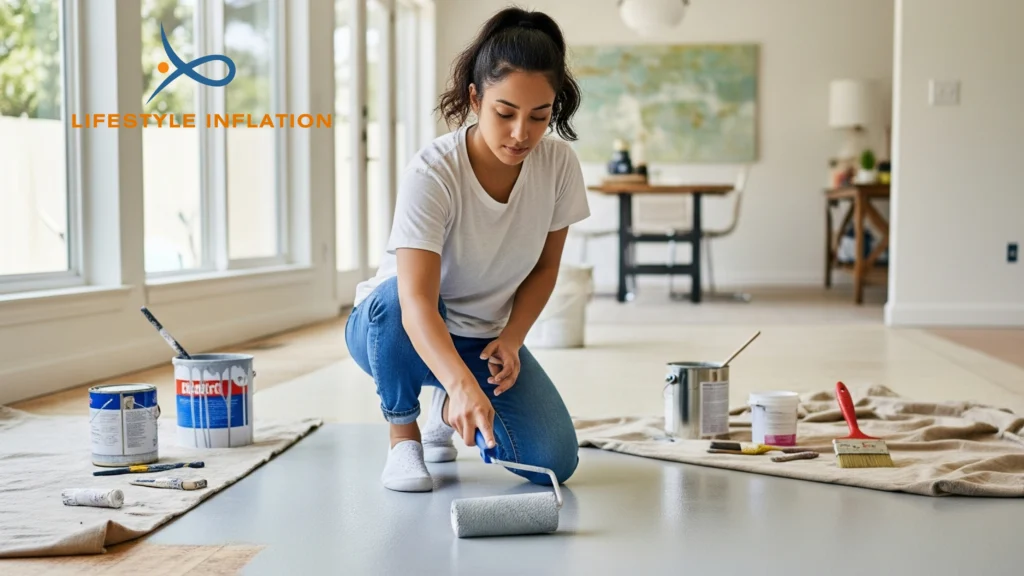When it comes to home improvement projects, sometimes even small changes can make a significant difference. If your linoleum floors are looking old, worn out, or outdated, you may be asking yourself: can you paint linoleum floors?
The good news is — yes, you can paint linoleum flooring and transform the entire look of your space without the hassle or expense of replacing the floor.
In this complete guide, we’ll walk you through how to paint linoleum floors step-by-step, share expert tips, and discuss the best products for a successful linoleum painting project.
Can You Paint Linoleum Floors and Why You Should Consider It

Painting linoleum floors offers an affordable and creative way to refresh your home. Many homeowners are surprised at how dramatic the transformation can be with just a few coats of linoleum paint.
Whether you’re tired of outdated patterns, want to match modern decor, or simply need a budget-friendly solution, painting linoleum flooring offers several benefits:
Key Benefits
- Cost-Effective Makeover: Full floor replacement can cost thousands of dollars. In contrast, painting linoleum floors requires a small investment in supplies and some elbow grease.
- Customization: You are not limited to what’s available in flooring stores. You can select any color scheme, design, or pattern to create a completely unique look.
- Minimal Disruption: Replacing flooring can be noisy, dusty, and time-consuming. Painting a linoleum floor allows you to complete your project in just a few days.
- Eco-Friendly Option: Instead of throwing old linoleum into landfills, you can extend its life by simply updating it with paint.
Can You Paint Over All Types of Linoleum Floors?
Yes, but with a few considerations. Whether you have old or new linoleum, or even vinyl flooring, the process for painting over linoleum is similar. However, older floors may require extra preparation to ensure the paint adheres properly.
Before starting, inspect your flooring for:
- Deep scratches or gouges
- Areas where the linoleum may be peeling
- Uneven surfaces or bubbles
These issues should be repaired or smoothed out during the preparation stage.
What Tools and Supplies Do You Need?
Before you begin painting linoleum, make sure you have the following supplies:
- Heavy-duty cleaner (like TSP or ammonia-based cleaner)
- Medium-grit sandpaper (120-150 grit)
- Vacuum and mop
- Painter’s tape
- High-quality bonding primer (Zinsser Bulls Eye 1-2-3 is a popular option)
- Paint for linoleum floors (epoxy, acrylic latex, or polyurethane-based)
- Paint rollers and brushes
- Clear polyurethane sealer
- Drop cloths and protective gear
Preparing Your Linoleum Floors for Painting

Preparation is the most important part of painting linoleum flooring. Skipping or rushing through these steps can lead to peeling, cracking, or an uneven finish.
Step 1: Thorough Cleaning
Begin by deep-cleaning your linoleum. Remove all dirt, grease, wax, and buildup. You can use a heavy-duty degreaser or a mix of warm water and ammonia. Allow the floor to dry fully before proceeding.
Step 2: Sanding the Surface
Sanding creates a rough surface for the primer and linoleum floor paint to adhere to. Lightly sand the entire floor using medium-grit sandpaper. Vacuum and wipe the floor clean after sanding.
Step 3: Repairs
Check for cracks, gouges, or imperfections. Use a linoleum repair compound or epoxy filler to patch any damaged areas. Smooth out the repairs with fine sandpaper once dried.
Step 4: Apply Primer
A bonding primer helps the paint stick and prevents peeling. Apply one or two coats of primer, making sure to cover every inch of the floor. Let each coat dry fully before moving on.
Choosing the Right Paint for Linoleum Floors

The success of your project heavily depends on selecting the right paint for linoleum floors.
Best Paint Options
- Epoxy Floor Paint: Offers extreme durability and moisture resistance. Ideal for kitchens, bathrooms, and high-traffic areas.
- Acrylic Latex Paint: Easier to apply and clean, but not as durable for heavy foot traffic. Best for low-traffic rooms.
- Polyurethane-Based Paint: Provides a hard, glossy finish and excellent protection against moisture, stains, and scuffs.
If you’re wondering what paint to use on linoleum floor, epoxy or polyurethane are usually the safest bets for long-term durability.
How to Paint Linoleum Floors: Step-By-Step Guide
Now that preparation is complete, let’s go through the full process of painting a linoleum floor:
Step 1: Apply the Base Coat
Start by applying your base color using a high-density roller. For edges and corners, use a high-quality brush. Allow the first coat to dry completely before applying a second coat.
Step 2: Create Designs (Optional)
For a creative touch, consider adding designs:
- Use painter’s tape to create geometric patterns or stripes.
- Stencils can help you apply more intricate designs.
- Consider checkerboard or faux wood grain patterns for a classic look.
Be sure to carefully remove tape before the paint fully dries to avoid peeling.
Step 3: Apply the Sealer
Once your paint is fully dry, apply at least two coats of clear polyurethane sealer. This protective layer enhances the durability of your painted linoleum floor and makes cleaning easier.
Floor Painting Ideas & Inspiration

Looking for some design inspiration for your floor painting project? Here are a few creative ideas:
- Modern Geometric Patterns: Use bold colors and shapes for a contemporary look.
- Classic Checkerboard: Black and white checkerboard is timeless.
- Rustic Faux Wood Finish: Create a natural wood look using a wood-grain tool.
- Vintage Stencils: Add old-world charm with decorative patterns.
How Long Do Painted Linoleum Floors Last?
The longevity of painted linoleum floors depends on:
- Proper surface preparation
- Quality of the paint and sealer used
- Level of foot traffic
With proper care, a well-maintained painted linoleum floor can last anywhere from 3 to 5 years or more before requiring touch-ups.
Maintenance Tips for Painted Linoleum Floors

To keep your newly painted linoleum floors looking fresh:
- Clean regularly with a damp mop and mild cleaner.
- Avoid harsh chemicals or abrasive cleaners.
- Use furniture pads to prevent scratches.
- Reapply a protective sealer every few years if necessary.
Final Thoughts
So, can you paint linoleum floors? The answer is a definite yes! With proper preparation, the right products, and a bit of creativity, painting linoleum floors can breathe new life into any space. Whether you’re updating a kitchen, bathroom, or living area, this simple DIY project offers impressive results at a fraction of the cost of new flooring.
Happy floor painting!
Frequently Asked Questions (FAQ)
Can you paint over linoleum without sanding?
Sanding is highly recommended to create a rough surface for better adhesion.
Can I paint my linoleum floor in the bathroom or kitchen?
Yes, but use moisture-resistant paints such as epoxy or polyurethane.
Can I paint vinyl flooring the same way?
Yes, the process for painting vinyl floors is nearly identical to painting linoleum.
What’s the best paint for linoleum floors?
Epoxy or polyurethane-based paints offer the best long-term durability.
Is it worth painting old linoleum floors?
Yes! It’s an affordable, customizable way to refresh worn-out floors without full replacement.



